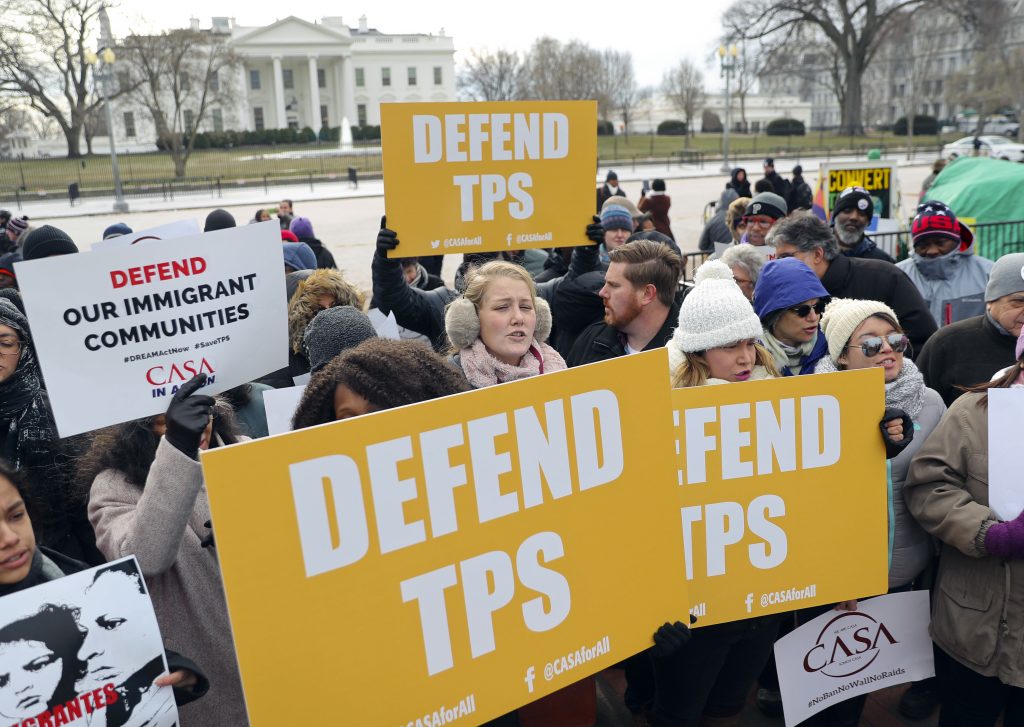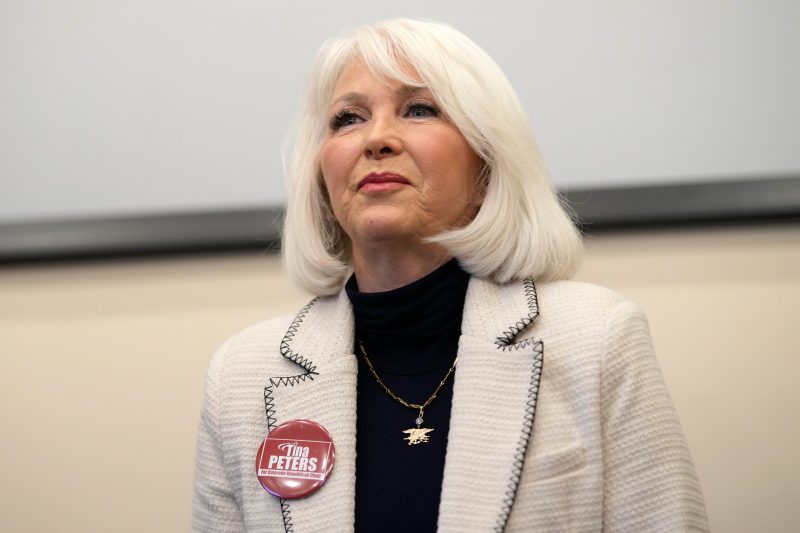Whom does Trump plan to deport? Whomever Trump wants to deport.

CASA de Maryland, an immigration advocacy and assistance organization, holds a rally in Lafayette Park, across from the White House in Washington, Monday, Jan. 8, 2018, in reaction to the announcement regarding Temporary Protective Status for people from El Salvador. The Trump administration is ending special protections for Salvadoran immigrants, forcing nearly 200,000 to leave the U.S. by September 2019 or face deportation. El Salvador is the fourth country whose citizens have lost Temporary Protected Status under President Donald Trump, and they have been, by far, the largest beneficiaries of the program, which provides humanitarian relief for foreigners whose countries are hit with natural disasters or other strife. (AP Photo/Pablo Martinez Monsivais)
A 7.0-magnitude earthquake struck Haiti in January 2010, most likely killing hundreds of thousands of residents and leaving hundreds of thousands more homeless. Recovery was slow, hindered in part by political unrest. In 2016, the island was battered by Hurricane Matthew, leaving hundreds more Haitians dead. Unrest escalated; the country’s president was assassinated in 2021. A month later, a 7.2-magnitude earthquake struck, killing more than 1,000 people. Violence driven by criminal gangs became rampant, including against the government.
Given all of the recent turmoil, the U.S. government has more than once extended “temporary protected status” (TPS) to immigrants from Haiti. One was offered in January 2010 during the Obama administration, in response to the earthquake. Another went into effect in August 2021, during the Biden administration, in response to the second earthquake.
In between, Donald Trump served as president for four years. During his first year in office, he allowed the TPS protection for immigrants from Haiti to expire, meaning that nearly 60,000 immigrants from that country would have a limited period of time during which to leave the United States. During a private conversation with legislators early in 2018, he made obvious why he might not have been compelled to extend the protection: He disparaged Haiti in vulgar terms, expressing his wish that immigrants instead came from (stable, prosperous) countries such as (predominantly White) Norway.
This was certainly revealing. Trump’s career in national politics was built on the presentation of some immigrants — those entering the United States from Mexico — as dangerous or undesirable. Other immigrants, including those admitted to take jobs at Trump Organization properties, were given a pass. Trump and many on the right insisted that they supported proper, legal immigration, but as with the immigrants from Haiti, demonstrated that the priority was often instead on policing which immigrants they felt deserved to remain. The Trump Justice Department launched an effort to figure out which immigrants who had earned citizenship might see that benefit revoked.
All of this is important context for the central plank of Trump’s 2024 bid for the presidency, his pledge that he would direct the government to deport millions of immigrants from the United States. The details of this proposal are often vague, as was the case when his running mate, Sen. JD Vance (R-Ohio), was asked about the idea during this week’s vice-presidential debate. Vance insisted that the administration would prioritize immigrants with criminal records but didn’t say much more than that.
He did, however, contest the idea that immigrants from Haiti who live in his state, immigrants who were given permission to enter the United States during the most-recent TPS designation, should not necessarily be considered “legal” — and therefore exempt from being asked to leave. He’s said this before, so it was not exactly surprising.
In an interview with NewsNation on Wednesday, Trump was asked about these immigrants who now live in the Ohio town of Springfield.
“What’s happening there is horrible,” Trump said. “You have a beautiful community, 52,000 people, and about 30,000 people were put into that community rapidly.” (For what it’s worth, the population was about 59,000 in 2023, with the number of immigrants from Haiti probably numbering 10,000 to 12,000.)
“Everything was nice. It was like a picture community,” Trump said. “And all of a sudden, in a short period of time, they have 32,000 more people in there. It doesn’t work. It can’t work.”
The reporter asked whether he would revoke TPS for those immigrants.
“Absolutely,” he replied. “I’d revoke it, and I’d bring them back to their country.”
The ostensible issue here is that Springfield has a large population of newly arrived immigrants that are putting strain on the town and its government. (It is common for immigrants to join existing immigrant communities given the accompanying support structures they offer.) But Trump’s solution isn’t to bolster Springfield’s resources or even to find ways to better accommodate the new arrivals elsewhere. There are lots of places — particularly rural, Republican-voting ones — where an influx of working-age residents would be an unalloyed boon. But Trump’s solution, instead, is to send them back to a country upended by instability and natural disaster. It is punitive.
Trump’s answer gives the lie to his and his running mate’s insistences that they are targeting immigrants in the country illegally, much less that their focus is on those who’ve committed crimes. This week, Vance and other Trump allies spread false claims about an influx of criminals under the Biden administration, an effort to fearmonger about immigrants to the United States that also revealed the extent to which criminality could be used as a pretext for deportation. Is an immigrant who has served a sentence related to gambling or obscenity someone whom we urgently need to expel from the country? Particularly if, as was presented as a scenario to Vance at the debate, they have children who are U.S. citizens? (Vance declined to say whether that would be a factor in deciding how to go about removing people from the country.)
It is by now well-established that the process of identifying, detaining and removing millions of people from the country would be enormously challenging and destabilizing, both economically and to individual communities. What Trump’s and Vance’s claims have reinforced is that it would also be arbitrary, with legal immigrants viewed as undesirable to the president and his supporters slated for ouster, while other groups remain in relative protection.
The issue has never really been about protecting the country or American citizens. If it had been, Trump wouldn’t make false claims about the scale and danger of immigrants to the United States. The issue, instead, is that it is politically useful to Trump to make those false claims and that Trump appears to have a personal aversion to immigrants from the Caribbean, Africa and Latin America.
Those are the immigrants who are obviously most at risk, regardless of how assiduously they followed the rules on their journey to the United States.





